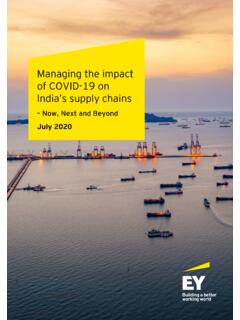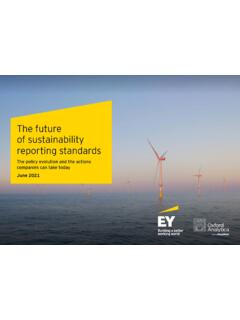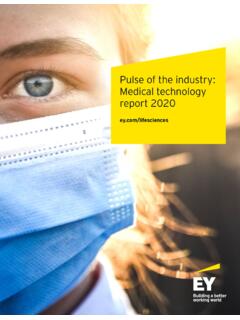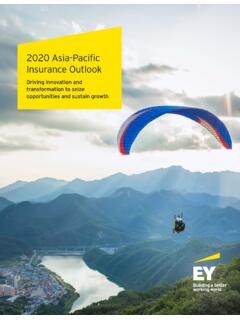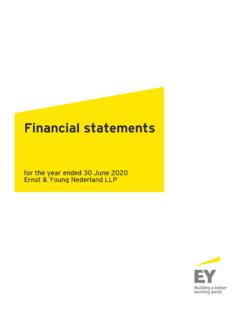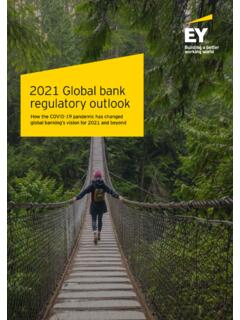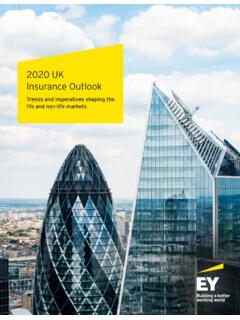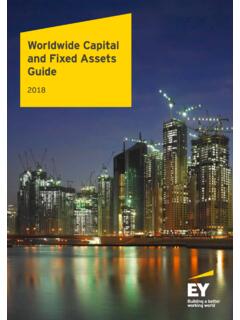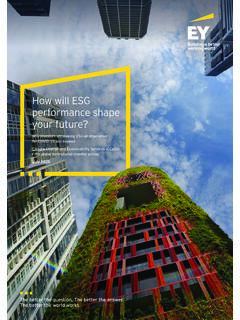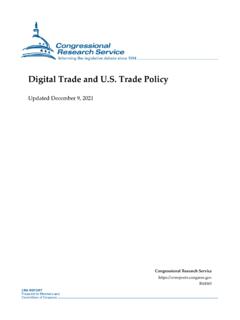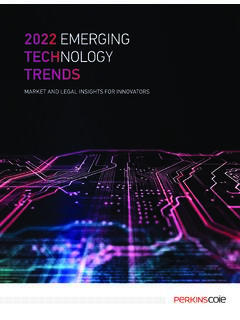Transcription of Are you reframing your future or is the future reframing you?
1 Are you reframing your future or is the future reframing you?Megatrends 2020 and beyond | EYQ 3rd edition | megatrends will help you see opportunities where others don 2020 and beyond | The world changed in March 2020. Almost overnight, the COVID-19 pandemic strained health care systems to the breaking point, put much of the global economy on an indefinite hiatus and radically reshaped societal norms and interactions. For businesses everywhere, these events are undermining established assumptions while catalyzing new models and approaches. ForewordThe crisis has accelerated transformation. One way of thinking of this is using the S-curve pattern of growth in which a paradigm or technology is adopted gradually at first, then rapidly, before slowing again in the end stage as the model matures and delivers diminishing returns. COVID-19 has thrust the entire global economy onto a new S-curve.
2 The global system has been on the current curve, driven by a prolonged wave of globalization and information technology adoption, for decades. To succeed on this curve meant driving a company toward global market leadership and creating value based on ever-larger scope, scale and efficiency. This created sustainable and defensible competitive advantages for decades. But lately, the curve has been waning, as a global economy built on unfettered take, make, waste has delivered increasingly unsustainable societal, environmental and business outcomes. The next S-curve has been visible for a while now. It doesn t yet have a name, but it is essentially the future we describe in our megatrends reports. In this future , social contracts will be rewritten to be more inclusive and sustainable, compelling businesses to take a more proactive role in creating long term value. The global system will be reshaped by everything from shifting power dynamics to 3D printing.
3 Human augmentation technologies, such as artificial intelligence (AI) and the Internet of Things, will transform every human domain, from consumer behavior to the nature of work. So far, these have been long term trends over a distant horizon. In one fell swoop, the COVID-19 pandemic changed that. It has moved us, almost overnight, into a new renaissance, a global reset. In an instant, many of us have been compelled to adopt remote work, virtual learning and online shopping. These changes are often proving to be more effective and sustainable, and they will likely be sustained in the long term. The pandemic has also brought the fault lines of economic inequality into sharp relief, highlighting that we are all made more vulnerable by weaknesses in our social safety nets. This could catalyze trends we have been discussing for some time populism, renewed social contracts, long term value and new economic metrics and accelerate the move to the next S-curve.
4 These developments make a megatrends-based approach more relevant than ever. For one, the rapid technology adoption and other changes catalyzed by the crisis have suddenly made the megatrends from future of work to health reimagined to superconsumers more near-term. CEOs and boards need to focus on them now to remain competitive. | Megatrends 2020 and beyond The crisis has also brought home a central tenet of our megatrends approach: that disruption does not come from technologies and business models alone. It can equally be unleashed by national elections, climate disruption or, in this case, a pandemic. More than ever, your strategy needs to look far beyond your traditional sector and legacy competitors to identify potential threats and opportunities. The megatrends are designed to enable precisely such an approach. This is not entirely uncharted territory. In recent years, some companies have become market value leaders by operating by the rules of the new S-curve.
5 These companies have been labeled as disruptors or unicorns labels that make them sound rare, almost mythical. In the world beyond the pandemic, they will be anything but. Every company will need to revamp its strategy and approach to operate by the rules of the new S-curve. A key part of your approach in this new environment should be future -back planning, as explained in the first chapter of this report. The megatrends are a valuable basis to generate new planning scenarios, define a relevant purpose for the future and execute with urgency all with the goal of becoming a more resilient and transformative company. The megatrends discussed in this report existed prior to the pandemic and will continue to move forward in its aftermath. While COVID-19 has upended much of the world, the basic framework of the megatrends the forces driving them and the future working worlds they enable remain as relevant as ever.
6 How will you thrive in this new environment in which humans are at the center, technologies are leveraged with greater speed, and innovation scales quickly? The global EY organization stands ready to help War IIGlobal industrializationThe post-war S-curveThe better world S-curveTechnology efficiency boomPandemic resetNew renaissanceMigration to new S-curveCOVID-19 and the migration to a new S-curveJay NibbeEY global Vice Chair MarketsMegatrends 2020 and beyond | CONTENTSU sing megatrends to shape your strategy 4 Primary forces 12 Powering human augmentation 14 Beyond globalization 16 Gen Z rising 18 Exponential climate impacts22 Megatrends 26 Decarbonization28 Techonomic cold war 34 Behavioral economy40 Synthetic media 46 future of thinking52 Work and life unbounded58 Microbiomes64 Synthetic biology70 future working worlds 78 Africa s new century80 New economic metrics 86 Mending social fabric92 Endnotes98
7 Acknowledgments100 Your EY Megatrends contacts1041 | Megatrends 2020 and beyond Megatrends 2020 and beyond | 2 USING MEGATRENDS TO SHAPE YOUR STRATEGY3 | Megatrends 2020 and beyond USING MEGATRENDS TO SHAPE YOUR STRATEGYU sing megatrends to shape your strategyMegatrends 2020 and beyond | 4 Imagine rebuilding a Formula One car not in pit lane, but as you hurtle around the track. That s the challenge business leaders face in this moment of disruption. The recent global pandemic and its fallout on businesses has been the greatest global disruption in modern history. It is permanently changing the future of society, work, geopolitics and businesses. If conducting future -back planning based on megatrends and scenarios was important before, it is now critical. This way of thinking and resetting for the future will determine which companies exit the pandemic cycle in a renaissance and which will become irrelevant.
8 Leadership teams have always found it hard to plan using megatrends and scenarios despite the best intentions. Why? Because future disruption raises challenges and questions with no easy answers: First, disruption comes from far afield. It can emerge from uncontrollable wildfires, geopolitical power shifts or a global pandemic that shuts down society and commerce. Some companies, labeled disruptors, start to build businesses that will thrive within the disruptive scenarios and operate on a different set of value drivers. Yet, incumbent market leaders often find it hard to even imagine the potential impact of scenarios that may disrupt an entire industry, customer needs or company relevance. How do you make sure you don t miss the next disruptive shift? How do you identify the uncertainties or trends you re afraid to confront? Second, disrupting yourself requires placing long term bets on untested approaches and models.
9 At the same time, disruption reshapes the competitive landscape, creating tremendous uncertainty about the assumptions and projections underlying those long term bets. Balancing these two forces is not impossible it just needs the right innovation approach How do you optimally invest scarce resources in a multi-horizon portfolio, given this uncertainty? How do you identify which models and approach will succeed? Third, disruption requires you to make investments that might ensure your relevance and survival in the long term, but could hurt financial performance in the short run the fundamental tension underpinning the innovator s dilemma. How do you invest for long term disruption while continuing to win in the short run? How do you solve the now, explore the next and imagine the beyond?These challenges are thorny, but not insurmountable if you take a structured and deliberate approach. We have found that a future -back strategy development process works best: using megatrends as a key analytical tool to envision where you ll be in the future , then working backward to craft strategies for today.
10 This method flips the script on the standard approach to developing projections, plans and strategy, which uses the current state as the starting point. It is particularly suited to disruption, which creates entirely new markets and ecosystems that make extrapolations based on historical trends meaningless. future -back thinking also broadens the perspective of executives, helping to confront the reality of potential futures where the company could become irrelevant or the industry itself totally redefined. 5 | Megatrends 2020 and beyond Megatrends and future -back strategyA major strategic risk companies face is developing plans that assume today s industry structure, competitors and profit pools will persist through the 5-to-10-year planning horizon. Our megatrends help challenge these assumptions. They expose teams to trends and forces far outside their usual scope of analysis, reducing the risk of missing the next big thing.
